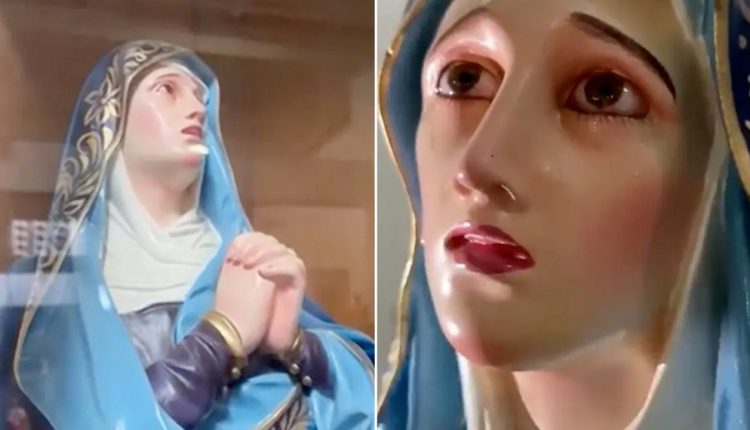A statue of the Virgin Mary in the Mexican state of Colima that is reportedly weeping tears has drawn crowds of onlookers and questions about a potential miracle.
The statue was first noticed “crying” in October — but videos of the statue’s purported tears gained traction on social media in mid-November.
The statue, which is encased in glass, is named the Virgin of Dolores. It’s located in the town of El Chanal, which is near the city of Colima, the capital of the state with the same name.
VIRGIN MARY STATUE WITHSTANDS EARTHQUAKE IN TURKEY AS CATHEDRAL COLLAPSES: ‘INSPIRING SYMBOL OF HOPE’
“Dolores” translates to “sorrow” or pain.”
In Catholicism, one of the titles of the Virgin Mary is Our Lady of Sorrows, inspired by a prophecy in the Gospel of Luke.
“So, a couple of tears started flowing,” eyewitness Víctor Ramos told the news outlet CEN.
The statue’s eyes reddened as she “cried,” claimed Ramos.
“Similarly, when we cry, and our eyes become red, the same happens to the image,” Ramos said.
WHAT ARE ANGEL NUMBERS AND WHY DO PEOPLE KEEP SEEING THEM?
Perhaps the statue’s tears were a reaction to the “violence rates that are being experienced here in the state of Colima, also here in the community,” said Ramos.
The U.S. Department of State is right now warning against traveling to the entire state of Colima due to “crime and kidnapping.”
In 2022, the city of Colima had a homicide rate of 181.94 homicides per 100,000 residents, said Mexico’s Citizens’ Council for Public Safety and Criminal Justice. This was the highest in the world.
Ever since videos of the supposedly crying statue went viral on social media platforms, the church has experienced a slew of visitors hoping to see the crying statue for themselves.
Two Catholic priests told Fox News Digital that they were hesitant to endorse any devotion to the supposedly miraculous occurrence.
“Often, there’s a natural explanation for these sorts of things.”
“These phenomena have to be subject to the judgment of the Church, which usually comes from the local bishop after an investigation and hearing experts on the matter,” said Fr. Thomas Petri, O.P., president of the Dominican House of Studies in Washington, DC.
“Often, there’s a natural explanation for these sorts of things,” he said.
But even after an investigation by Church authorities in which no natural reason is found, “Catholics are not obliged to believe in these phenomena,” said Petri.
AS CATHOLIC CHURCH FACES PRECARIOUS CULTURAL TIME, BISHOP ROBERT BARRON OF MINNESOTA MODELS THOUGHTFUL FAITH
“However, we can always be grateful for any event or occurrence that causes people to pause and think about God and heavenly realities,” he added.
Fr. Paul Hedman, a priest of the Archdiocese of Saint Paul and Minneapolis and a self-described “skeptic” on these types of phenomena, also urged caution.
“People should remain indifferent and not get too excited until the Church is able to investigate,” he said.
A crying statue, said Hedman, could be caused by something such as condensation, or “outright fraud by those looking to make a buck.”
“I would generally encourage people to maintain a healthy skepticism — the truth will come forward, and it is better to be cautious than to pour your soul into something that turns out to be inauthentic,” he said.
Statues that appear to be crying or experiencing other such unusual things are an uncommon but not unheard of phenomenon — and is not limited to Christianity.
In 1995, India experienced a full-blown frenzy after it was reported that statues of the Hindu god Ganesh appeared to be drinking milk, The Independent reported at the time.
In September of that year, rumors began swirling throughout India that statues of Ganesh were miraculously drinking milk that was offered on spoons, said The Independent.
It is a Hindu custom to offer food and drinks to statues of gods.
Milk sales in New Delhi rose by 30% over the days that followed as curious Indians tried to see if their statues would also drink milk, said The Independent.
Scientists later said that the statues’ supposed consumption of milk was actually a natural phenomenon known as “capillary action.”
For more Lifestyle articles, visit www.foxnews.com/lifestyle.
Read the full article here

